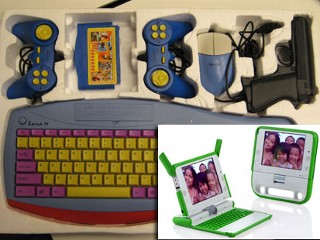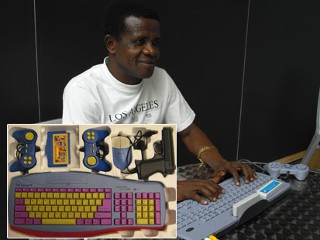As the prices of educational laptops for children in developing countries creep upward, a group of researchers attempts to create a new, even lower-tech computer that would cost as little as $12.
While wandering the streets of Bangalore, India, in February during an internship for Qualcomm, 27-year-old graduate student Derek Lomas stumbled across a contraption that looked quite similar to the original Nintendo console that he played video games on as a kid in the 1980s.
Variations on that original console sell in India for anywhere between $10 and $20 and plug into your TV, complete with game controllers and a computer keyboard. The consoles eventually expanded their game repertoire beyond "Duck Hunt" rip-offs to very basic word processing software.
After tooling around with the gadget, Lomas had an idea. "I started thinking about how to make a project that would redesign some of the content and experience so it was more effective in teaching basic skills," he said.
Lomas, along with designers and engineers from Ghana, Brazil, Peru and India, presented the idea this week at MIT's International Development Design Summit, which challenges designers to create technology in four weeks that can help people in developing countries.
At the conference, the group presented the same console, but with modifications -- such as flash memory -- so users could save their work, and wireless connectivity, as well as development plans for more educational software. For now, the computer is just a proposal, but according to Lomas, companies have already expressed interest.
He hopes that in a country like India, where half the population owns televisions, a device like this could introduce a whole new segment of the population to computers and potentially, a better life.
Having skills as simple as typing could push citizens, especially those in areas where data entry outsourcing is common, into a higher income bracket, Lomas hypothesized.
"We're not going for the absolutely poorest person we can find, but aspiring middle class with very low incomes but [who] have access to a television," he said.
The idea of a $12 computer sounds as fantastical as the idea of $100 laptop did two years ago when Nicholas Negroponte unleashed the long-awaited XO, the green-and-white solar-powered brainchild of One Laptop Per Child. It turns out that the XO -- or at least its $100 price tag -- was fantastical. The cost progressively moved upward before reaching its current price of $187.
Just like the OLPC before it, the $12 price tag makes for great headlines, even if it is only "a step above a calculator," as one expert put it.
"It's a fascinating concept in that it tried to redefine the bottom of the computer segment, just like the OLPC decided to define the floor as $100," said Rob Enderle, a Silicon Valley Tech analyst. "The floor was closer to $200."
For emerging countries, that price can make a huge difference, he said.
"Twelve dollars is an awful lot of money to them, and they might only need certain capabilities. If you start with a $12 core you can probably add a lot of that stuff and stay under $50," Enderle said. "Any time you move the bottom of a market down, anyone who's building in that market gets concerned."
But Chuck Kane, OLPC's president and COO, didn't seem too concerned by the news of a plug-in computer.
"I applaud anyone who's trying to get something out there to developing countries, but I just think it's apples and oranges we're looking at here," he said.
Clearly, the XO and its U.S.-based competitor, the Intel Classmate, are quite different from Lomas' ultra-basic computer concept. The XO is a real laptop, albeit not a high-performance one like the MacBook Air.
But just as competition at the sophisticated high end of the computer market has engineered remarkable innovations, competition at the low end will also bring innovation.
"[It's] one more example of the size of the competition Nick Negroponte kicked off when he first proposed the $100 laptop," technology forecaster Paul Saffo wrote in an e-mail. "And of course very much goes with the grain of Moore's law."
First mentioned by an Intel co-founder in the 1960s, Moore's Law states that every year, more transistors can be place on a circuit doubles every two years. The idea behind the law is that technology will exponentially get cheaper, faster and more useful.
Walter Bender, the former president of OLPC's software and content, is heartened by the group's new competitors and Lomas' project, even if he doesn't think it's completely practical.
"It's a very limited way of thinking about how you use computers and what you use computers for and how we use computers for our own learning," he said. "Nonetheless it's certainly one approach in a problem that needs many solutions. ... It's certainly better than nothing, and for a lot of people that's the choice."
"There must be 30 different offerings in that space now, and some of them will be interesting," said Bender. "It's great that there are people who are working in the space now."
But not all consumer electronics expansion into the outdoor urban markets of Third World countries is going to be for solely altruistic reasons.
"In general, we see now the entire PC market more concentrated on the developing world, whether it's Brazil or China or India," said Steve Baker, an analyst at NPD Group. In the United and States and Western Europe, "the markets for computers are pretty well saturated and are very mature. ... And the PC companies or anybody who wants to sell to those markets is going to have to create product that deals with the income levels and usage patterns that go on in those places."
Baker called the MIT presentation "a nice idea," but questioned whether, at least in India, this was something that consumers wanted or needed.
"This is a nice thing but obviously the XO [people] have had a difficult time getting their propositions up and running and these guys are likely to find the same kind of thing happen," he said. "Maybe we'd better off providing [electricity]."


No comments:
Post a Comment